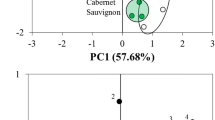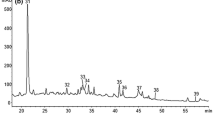Abstract.
Cork polyphenols susceptible to migrate into wine were studied in ten different types of natural and agglomerated cork stoppers, made of one and several pieces. Both low molecular weight polyphenols (LMWP) and ellagitannins (ET) were analysed by HPLC. Moreover, the molecular weight distribution was determined in tannic fractions. The LMWP gallic, protocatechuic, vanillic, caffeic, ferulic and ellagic acids; vanillin, protocatechuic, coniferilic and sinapic aldehydes, aesculetin and aescopoletin; and the ET castalagin, grandinin, vescalagin and roburin E were evaluated in all the samples. These LMWP and ET, found also in oak wood in different concentrations, play an important role in wine ageing. Although natural cork stoppers yielded, in general, higher amounts of polyphenols than agglomerated cork stoppers, no significant differences were found among the different types of cork stoppers.
Similar content being viewed by others
Author information
Authors and Affiliations
Additional information
Electronic Publication
Rights and permissions
About this article
Cite this article
Varea, .S., García-Vallejo, .M., Cadahía, .E. et al. Polyphenols susceptible to migrate from cork stoppers to wine. Eur Food Res Technol 213, 56–61 (2001). https://doi.org/10.1007/s002170100327
Received:
Issue Date:
DOI: https://doi.org/10.1007/s002170100327




